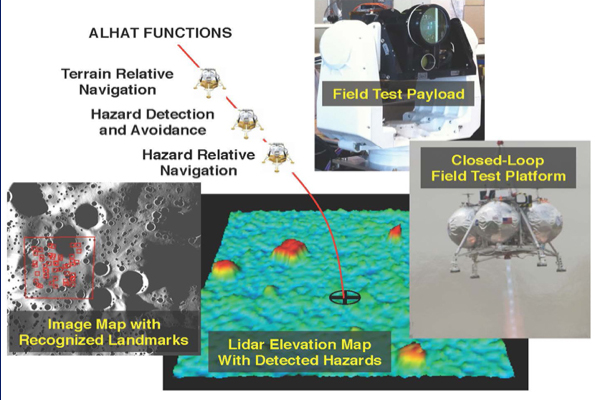Future NASA spacecraft will be able to safely land on the Moon, Mars and even an asteroid, in potentially hazardous terrain areas, all autonomously. And NASA’s Autonomous Landing Hazard Avoidance Technology (ALHAT) team is in the process of making it happen.
Led by Johnson Space Center (JSC) and supported by Jet Propulsion Laboratory and Langley Research Center, ALHAT provides a planetary lander the ability to precisely land safely on a surface while detecting any dangerous obstacles such as rocks, holes and slopes. Recent tests were conducted at NASA Langley to tests ALHAT’s hazard detection system.
“If you want to go where there’s any kind of roughness or any kind of hazards – you want to land safely without destroying your vehicle or crashing your vehicle – you need this kind of system,” said JSC ALHAT Project Manager, Chirold Epp.
The system was placed on a truck with the main goal of imaging a target approximately 2,500 – feet away. This allows the team to see how well they image and can navigate while driving.
Yet none of this would be possible without NASA Langley’s contributions to ALHAT. NASA Langley has created three light detection and ranging sensors: the flash lidar, Doppler lidar and high-altitude laser altimeter.
The flash lidar uses imagery technology to detect anything bigger than the size of a basketball, under all lighting conditions, on a planetary surface. If there is an obstacle, the ALHAT System will divert the vehicle to a safer landing spot.
“It’s a flash lidar because the laser flashes and acts like a flash camera,” said flash lidar systems engineer Eric Roback.
Additionally, the Doppler lidar measures the vehicle’s altitude and velocity to precisely land on the surface, and the high-altitude laser altimeter provides data enabling the vehicle to land in the chosen area.
The team is eager to see all of the components work together.
“It’s never been demonstrated, never been done,” Epp said. “So it’s our goal to demonstrate that for the first time, prove the concept – prove our sensors.”
ALHAT will be tested on a helicopter and then on Morpheus, a vertical test bed robotic lander prototype.
“Morpheus will fly using GPS first with our sensors taking data to make sure everything is working,” Epp said.
On a planetary lander, GPS will be unavailable, therefore, the vehicle will navigate by only using the sensors. “Then … the vehicle will launch; our sensors will image the field; the vehicle will go where we tell it into this nice safe spot and land there,” Epp said.
ALHAT surpasses human capability on a spacecraft and is critical to NASA’s future missions.
Sasha Congiu, NASA Langley
























